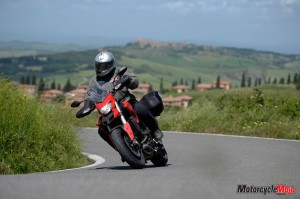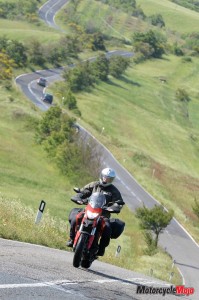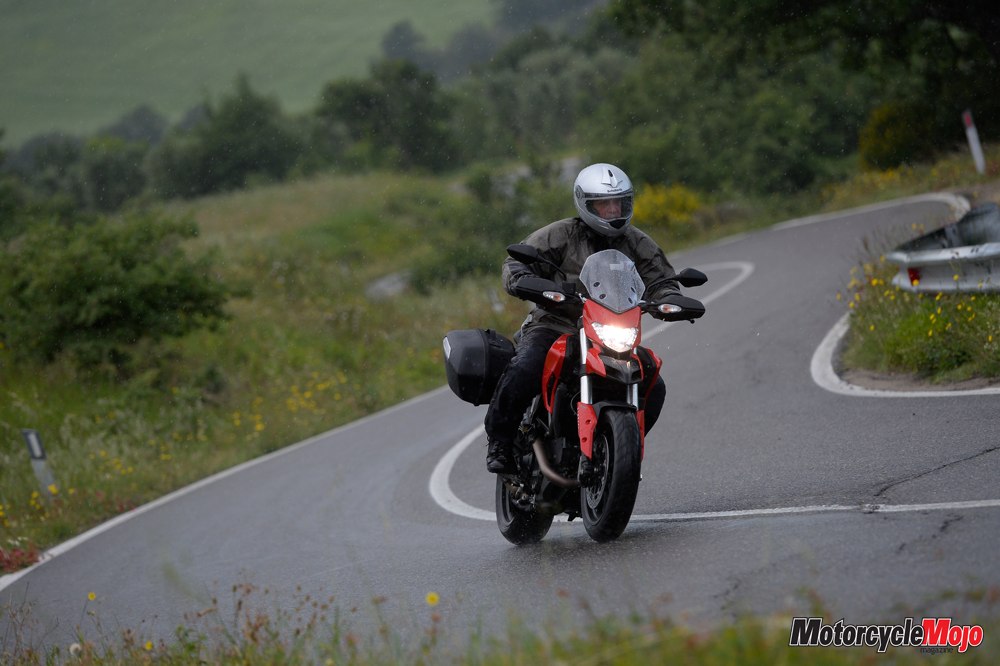Is Ducati’s newest offering, the Hyperstrada, the ultimate long-distance plaything? I think it just might be, providing twisty roads are involved.
Known for its amazing landscapes, ancient buildings, extraordinary paintings and sculptures, and world-famous wines, the Tuscany region of Italy might also now be known for having dozens of Ducati Hyperstradas ripping up its mountainous roads. And what better place to launch a new model from this fabled motorcycle brand than its country of origin? Suffice it to say that the Hyperstrada was bred for the type of twisting, undulating landscape that this beautiful, scenic area has to offer.
Sightseeing aside, I was in Italy for one reason, and that was to ride the new touring variant of the Hypermotard, a nimble motorcycle with a powerhouse 821 cc engine that produces a whopping 110 horsepower and pulls with an impressive 65.6 ft-lb of torque. The new Hyperstrada adds a whole new dimension to the functionality of the motard version and is much more than just a Hypermotard with panniers and a windscreen bolted on.
For starters, its handlebar risers are 20 mm taller, resulting in a more upright seating position, and a wider seat with thicker foam provides a more pleasant ride for hours on the road. Foot pegs are directly below the seat for a natural seating position. The passenger will be happier as well, as the rear portion of the seat is more horizontal and wider, making it more comfortable for extended rides. The rear sub-frame is also redesigned with better grab handles, and provisions have been made to mount the 25-litre panniers that are standard equipment, as well as an optional 31-litre top box. In addition to those items that set it apart from the Hypermotard, the Hyperstrada also comes with a pair of 12-volt power plugs, engine sump guard, centre stand (which all chain-driven bikes should have), and rear suspension specifically designed for the touring model.
 All told, the Hyperstrada makes for a very competent sport-touring machine, but let me stress that it is heavy on the sport side of that moniker. It is a Ducati, after all. It seems to be an ideal mount for the adrenaline-seeking sportbike rider looking for a bit more practicality and comfort, with the ability to get away for a weekend but still have a sporting machine. The panniers should also make it an ideal bike for the commuter.
All told, the Hyperstrada makes for a very competent sport-touring machine, but let me stress that it is heavy on the sport side of that moniker. It is a Ducati, after all. It seems to be an ideal mount for the adrenaline-seeking sportbike rider looking for a bit more practicality and comfort, with the ability to get away for a weekend but still have a sporting machine. The panniers should also make it an ideal bike for the commuter.
Ducati has fully embraced electronic technology, and like all Ducatis of recent years, the Hyperstrada is as technologically advanced as any other bike exiting the doors of the Bologna facility.
Within just a few miles of leaving the hamlet of Bagno Vignoni, our home base in the heart of Tuscany, I appreciated the different engine management modes. I could see heavy rain off in the distant hills, and knew we would soon be in the thick of it. With 110 horsepower on a bike that weighs a paltry 204 kg (450 lb.) wet (no pun intended), it would be easy to get yourself into trouble in slick hairpin corners without a safety net. Selecting the Urban mode ensured a safer ride on the twisty pavement when the rain, and even hail, hit us at the higher altitudes.
 The Hyperstrada has three riding modes. In Sport mode, the engine delivers a full 110 hp and instant response from the ride-by-wire throttle. Also, Sport mode has the lowest traction control (DTC) with a setting of level 3, and the least ABS intrusion. This ABS setting permits aggressive braking, allowing the rider to loft the rear wheel before it intervenes.
The Hyperstrada has three riding modes. In Sport mode, the engine delivers a full 110 hp and instant response from the ride-by-wire throttle. Also, Sport mode has the lowest traction control (DTC) with a setting of level 3, and the least ABS intrusion. This ABS setting permits aggressive braking, allowing the rider to loft the rear wheel before it intervenes.
Touring mode still delivers 110 hp, but brings it on more gradually, setting the DTC level to 4 with maximum ABS intervention. Urban mode drops the horsepower down to 75, with DTC set to level 6 with maximum ABS. Urban is ideal for city manoeuvrability and when traction is less than ideal, like carving corners on cold, wet mountain roads. The different ride modes offer a significant difference in how the bike responds to inputs, making the Hyperstrada extremely user friendly for a wide range of experience levels.
In addition to the presets, the level of DTC is selectable and can be saved in each ride mode from level 1 (expert riders) to level 8 for use in very low traction areas. DTC and ABS can be switch off as well if desired.
Other than short stints on multi-lane highways, there wasn’t a straight, flat section of road, and this type of terrain is where the Hyperstrada loves to be. Loading the panniers for a weekend in the mountains and getting away from it all is what this bike is all about. Once you get to your destination, remove the bags and go play.
The steering is light, and the nimble Hyperstrada seems to lean into corners by simple thought process. You don’t even realize you are steering into the corner until the bike is leaned over. An equally light push on the handgrip, and it changes direction with ease.
The Kayaba 43 mm inverted fork up front is not adjustable, but the rear Sachs remote reservoir shock that attaches to the bike’s single-sided swingarm offers preload and rebound adjustment. Even leaned over in bumpy corners, the suspension kept the tires in contact with the ground and offered a high level of confidence and feedback.
The newly designed tubular steel trellis frame surrounds the long and complex fuel tank. Holding 16 litres, the fuel tank sweeps back from the front to below the seat, helping to keeping the centre of gravity low. Also nestled in the trademark Ducati trellis frame is the jewel of the motorcycle, the new Testastretta 11° L-twin liquid-cooled engine.
The engine is responsive and smooth, and in Sport mode, it accelerates at lightning speed; remember, it is only 204 kg with all fluids in place. As it kicks butt coming out of corners, you really notice just how throaty and intoxicating the exhaust note is – it surprised me that it would pass legal noise limits . . . in a good way.
Once a bane to many Ducati owners was the complicated and frequent maintenance and valve-adjustment periods. Ducati has been steadily increasing the intervals between service and valve adjustments, and this second-generation Testastretta engine now extends the service intervals to 15,000 km and the valve adjustment intervals to 30,000 km.
Clutch action is light and shifting is smooth but positive. A good prod on the shifter is needed between first and second, but all other gear changes require a light nudge on the lever. The clutch utilizes a mechanism that offers a light pull, but mechanically increases pressure to the clutch plates using a servo system. The opposite comes into effect when gearing down, as the unit turns the clutch assembly into a slipper clutch to ensure stability and traction at the rear wheel when aggressively downshifting.
The Pirelli Scorpion Trail tires never hinted at breaking loose in the corners, and the Bosch-Brembo braking system was spot on, providing excellent feedback with just a light squeeze on the brake lever. Slow-speed manoeuvring is as intuitive as high-speed handling. While the seat height is a lofty 850 mm (33.5 in.), it didn’t feel top heavy, because the engine and fuel reside down low. If that seat height is too tall for you, a lower version of the Hyperstrada brings the seat down to 830 mm (32.7 in.), and available for either version is an accessory lower seat, which drops the base seat height by 20 mm.
The immediate view from the rider’s seat was minimal, but the single multi-function, dot-matrix, gauge assembly displays a dizzying amount of information – from a simple odometer to engine management and traction-control settings, and everything in between. Unfortunately, they ran out of room and couldn’t include a fuel gauge or the selected gear. Many of the settings are controlled via the left and right switchgear.
The mirrors did a good job, provided I wanted to keep an eye on my forearms. By tucking my elbows in, I could see behind me. I suppose on a bike like this, your main concern is any flashing red lights behind you. The windscreen did a great job of keeping the windblast off of my chest but left my helmet in clean air, so I felt no buffeting.
We experienced everything from cold wet pavement at high altitudes to low-lying meandering tarmac through picture-postcard farm country that offered an amazing labyrinth of twisty roadways. The Hyperstrada took it all in stride while offering an exciting ride. It may very well be the perfect bike for this type of getaway. It’s certainly an ideal bike to exit the urban jungle and discover twisting country lanes and mountain passes.
| The Basics | |
| List Price | $13,995 |
| Warranty | 2 years, unlimited mileage |
| Company URL | canada.ducati.com |
| The Drivetrain | |
| Engine Type | Testastretta 11°, L-twin cylinder, 4 valve per cylinder, Desmodromic, liquid cooled |
| Displacement | 821 cc |
| Power (claimed) | 110 hp (81 kW) at 9250 rpm |
| Torque (claimed) | 65.8 ft-lb (89 N-m) at 7750 rpm |
| Bore and Stroke | 88 x 67.5 mm |
| Compression Ratio | 12.8:1 |
| Fuel Delivery | Electronic fuel injection system. |
| Transmission | 6-speed |
| the essentials | |
| Final Drive Type | Chain |
| Front Suspension | 43 mm inverted forks |
| Rear Suspension | Progressive linkage with adjustable spring preload and rebound damping monoshock. Remote hydraulic spring preload adjustment |
| Wheel Travel | Front: 150 mm (5.9 in.); Rear: 150 mm (5.9 in.) |
| Brakes | Front: dual 320 mm rotors with 4-piston Brembo calipers; Rear: 245 mm disc with 2-piston caliper. ABS standard |
| Wheelbase | 1490 mm (58.7 in.) |
| Rake and Trail | 25.2 degrees/104 mm (4.1 in.) |
| Tires | Front: 120/70 ZR-17; Rear: 180/55 ZR-17 |
| Weight (wet) | 204 kg (450 lb.) |
| Seat Height | Standard 850 mm (33.5 in.) |
| Fuel Capacity | 16 litres |
| Fuel Economy (observed) | N/A |
| Fuel Range (estimated) | N/A |















































